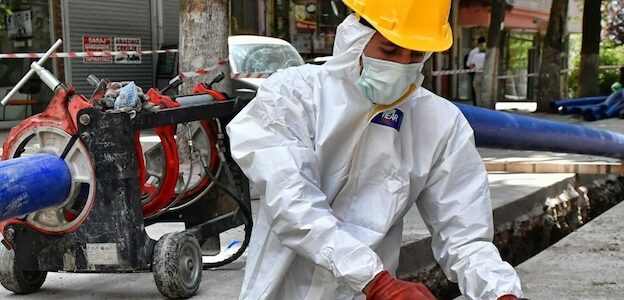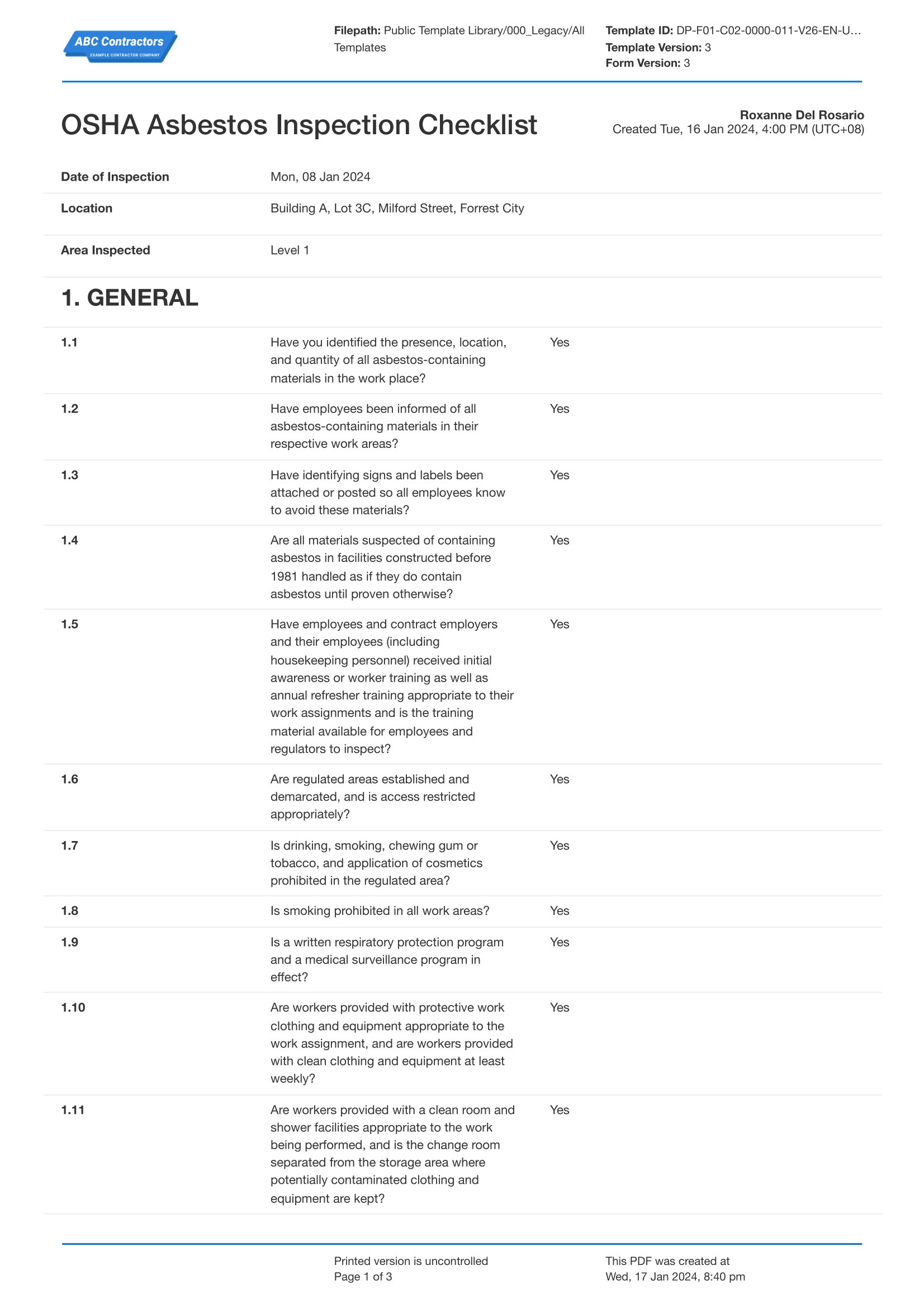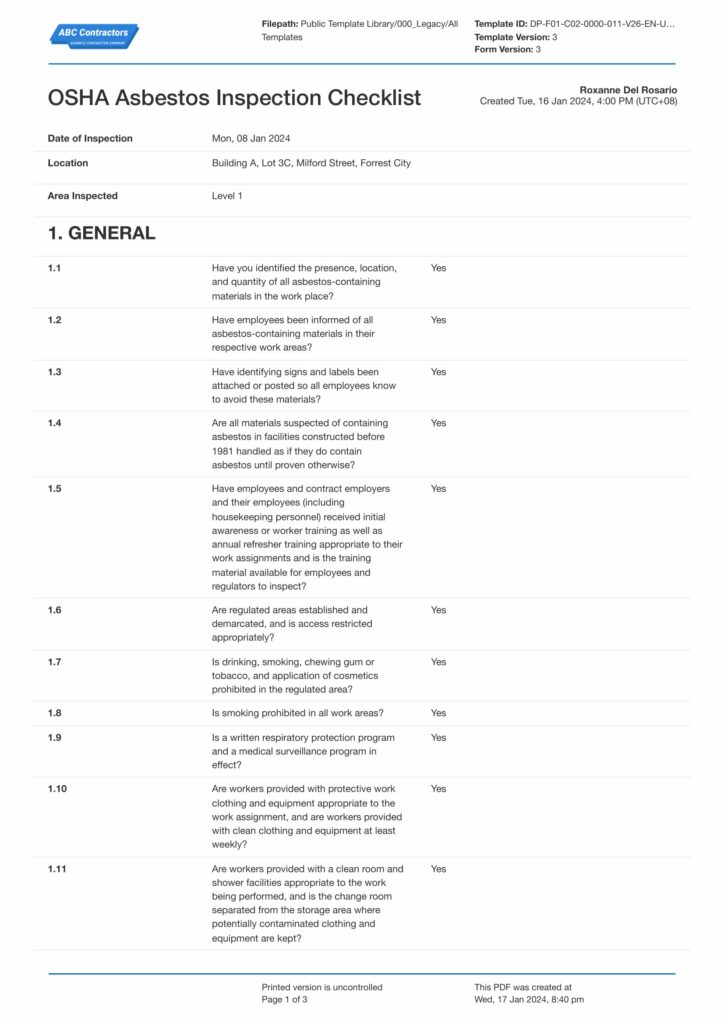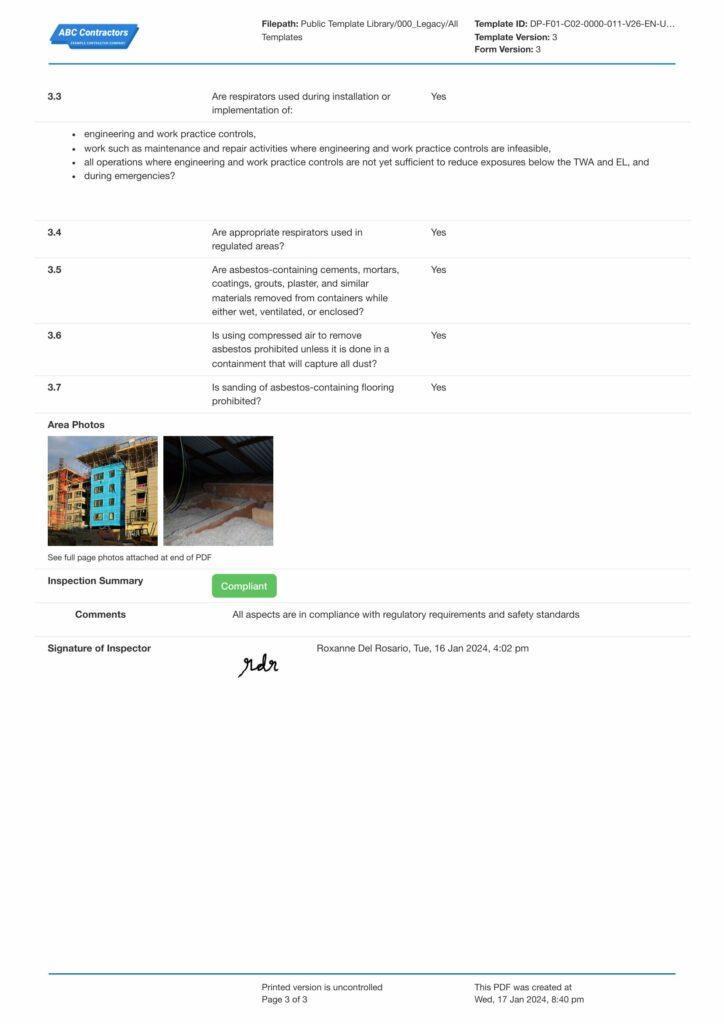Dashpivot Article – OSHA Asbestos Regulations
OSHA Asbestos Regulations
OSHA asbestos regulations are at the top of the pile in terms of safety requirements. Read on for a deeper dive on these asbestos regulations and how to manage them to stay compliant and safe.

Asbestos has been around for centuries because of its fireproofing and insulating properties, but the health effects weren’t known until recently. According to the International Labour Organisation Asbestos Convention, 1986 (No. 162), asbestos can cause asbestosis, lung cancer, mesothelioma, and more, hence OSHA asbestos regulations are usually near the top of the list when it comes to firm safety regulations.
Any type of asbestos must be monitored and isolated to prevent any harm, and this isn’t the first time the regulatory agencies will have to deal with an asbestos issue.
What is Asbestos?
Asbestos is a natural mineral made up of microscopic fibres stronger than steel yet as flexible as thread. Back then it was going to revolutionise the construction and manufacturing industry, but like many perfect solutions, it had hidden dangers that wouldn’t be revealed until many years later.
What’s so special about asbestos?
Asbestos is special because its silicon and oxygen atoms form irresistibly thin, strong, long threads. These fibres can withstand 1,000 degrees Fahrenheit (538 Celsius), don’t conduct electricity, and are resistant to corrosive chemicals. It seemed like nature’s perfect material for many industrial uses.
How is asbestos used?
For most of the 20th century, asbestos was used in almost everything, from insulating homes to roofing and floor tiles; it was the material of choice for builders and manufacturers. Ships, buildings, and even household appliances relied on asbestos for its amazing protective properties.
Why is asbestos harmful? - The reason we have OSHA asbestos regulations
Doctors noticed a pattern of lung diseases among workers exposed to asbestos, and the truth about the miracle material was out. Those same tiny fibres that made it so useful could become airborne, and when inhaled, could cause asbestosis, lung cancer, and mesothelioma. The microscopic fibres, once inhaled, could stay in the lungs for decades before showing their deadly effects.
Asbestos Mishandling Risks
Mishandling of asbestos can harm not just workers but the environment too. Here are some of the risks associated with asbestos mishandling:
Health risks and medical conditions
Mishandling of asbestos can cause serious respiratory conditions like asbestosis, lung cancer, and mesothelioma. These diseases have long latency periods, so symptoms may not appear until decades after exposure. Mesothelioma, a rare and aggressive cancer that affects the lining of the lungs, chest wall, or abdominal cavity, is almost exclusively caused by asbestos exposure.
Airborne transfer
When asbestos fibres are released during demolition or renovation, workers can inhale asbestos fibres. Tiny, microscopic asbestos fibres can mix with the air and stay suspended for longer periods of time. Workers can also find asbestos fibres sticking to their clothes, tools, or even skin, which can be carried home. Family members at home can also be exposed to asbestos, which can be a serious health risk.
Long-term environmental impact
Both indoor and outdoor environments can be contaminated when asbestos is mishandled. These tiny particles, once released into the environment, can stay suspended for longer periods and settle in soil and water systems. When not disposed of properly, building materials with asbestos can fill up landfills and can continue to pose environmental risks for future generations.
OSHA Asbestos Regulations, Rules and Guidelines
OSHA asbestos regulations protect everyone from the harms of asbestos, but are especially important to protect workers who handle it daily. This includes training, PPE and proper handling & disposal of asbestos-containing materials. Follow OSHA rules carefully so workers will be trained on how to work with asbestos.
Code of Federal Regulations (CFR): 29 CFR 1910.1001
The asbestos standards are found in the Code of Federal Regulations (CFR) at 29 CFR 1910.1001 for general industry and 29 CFR 1926.1101 for construction. These rules and regulations provide requirements, inspections, safety procedures, and employee training for asbestos in the workplace.
OSHA Asbestos Regulations: Things to Remember
OSHA has rules and regulations for the safe handling of asbestos, and here are the key things to remember:
OSHA — Permissible Exposure Limits (PELs)
OSHA permissible exposure limit (PEL) is 0.1 f/cc (time-weighted average, 8-hour work shift, 40-hour work week) with a most-exposed individual limit of not more than 1.0 f/cc for > 30 min. Employers must always ensure that no one is exposed to those limits.
Asbestos exposure monitoring and record-keeping
Employers themselves must determine if asbestos is present or if exposures or contaminations occur in the workplace. Once they've decided to go through OSHA, they'll need to measure up to the limitations of the predetermined exposure limits (PELs) and adhere to the monitoring requirements.
Environmental Control & Access Restrictions
Access should be limited to approved personnel only if PELs are exceeded for asbestos. Respirators should be used, as this will be required during high exposures. This limits exposure to a minimum area and prevents further contamination.
OSHA Asbestos Regulations Training and Education
Workers exposed to asbestos need training on asbestos risks, safe handling, and PPE use. Training must be done every year so workers will always be reminded that mishandling asbestos can lead to health issues or even be life-threatening.
Medical Watch
Workers exposed to asbestos at or above PEL or peak limit must join a medical programme with regular health tests and monitor if health issues arise.
OSHA Asbestos Regulation Record keeping
Keep records of exposure checks, air tests, medical checks, and training for at least 30 years to document everything. This will be your proof that you comply with OSHA regulations in case of audits and inspections.
How to follow and implement OSHA Asbestos Rules
Knowing the OSHA rules is the first step, and knowing how to follow them is next. Here are some tips to follow:
Asbestos checks and surveys
When workers are exposed to asbestos on a daily basis, it’s always a must to do asbestos checks and surveys. This will help identify risks and eliminate exposure to asbestos fibres and promote a safety culture in general.
Train on hazards and asbestos safety
Always train workers concerning the dangers involved in mishandling asbestos using regular training refreshers. This training should include handling techniques, the implications of wearing gear, and the mechanisms for safe asbestos removal and proper disposal of such materials. By doing so, we can lessen the likelihood of incidents involving asbestos fibre exposure through increased awareness and education.
Implement asbestos use procedures
There must be appropriate procedures in place, especially for industries where asbestos is used. Looking at areas with high risk of asbestos contamination and implementing these regulations proactively can make a big difference in the workplace. Most importantly, PPEs must be provided to employees handling asbestos.
Use this OSHA asbestos inspection checklist to monitor your organisation's asbestos safety procedures:

Use this checklist to stay compliant with OSHA asbestos regulations
Go digital with your OSHA Asbestos Inspections
One of the hardest aspects of complying with OSHA asbestos regulations and other safety regulations in general is to be able to prove compliance in the case of a safety audit or similar.
Many companies dealing with asbestos (construction companies, other industrial verticals etc.) still run their safety processes with paper forms, which makes documenting asbestos handling difficult.
One of the best ways you can improve your overall asbestos safety and compliance with OSHA asbestos inspections is by digitising how people assess risk and document their interactions with asbestos.
This can be done through generic softwares, or dedicated OSHA/safety apps.
Using these tools, your team can pull out a phone or tablet, conduct an asbestos inspection digitally, attach photo proof, and then submit that form straight back into a digital database where it's stored in your asbestos register.
Then when an auditor conducts an audit, all of your procedural proof is stored automatically and easy to find.
Build workflows for OSHA Asbestos Inspections
According to OSHA’s asbestos inspection guidelines, it’s always good to build workflows for inspections. This has never been easier with our OSHA Asbestos Inspection app, which has features that can be customised to fit your organisation.
The timeline view and a more detailed register view are how the OSHA Asbestos app keeps track of what inspections you’ve done with this OSHA Asbestos Inspection app by giving you a spreadsheet view of your submitted inspections.
Send reports to the team, location, or project for OSHA Asbestos compliance with just a few clicks.
OSHA Penalties for Non-Compliance
Fines, ranging from a few hundred dollars to even millions, can be incurred from non-compliance with OSHA asbestos regulations.
A company in Cicero, IL, was visited by OSHA in December 2010 due to exposing their untrained workers to asbestos. They were aware of the unsafe asbestos practices since 2002 but failed to provide proper safety measures until 2010. As a result, they were fined a total of $1,247,000 for not imposing asbestos safety rules.
Apart from fines and citations to employers for failing to observe asbestos regulations, direct employees affected by this outcome may file complaints leading to expensive judicial procedures. The company’s reputation will suffer, a threat that would chase away customers or potential clients.
In a Nutshell
Businesses risk losing both their employees and the public's trust if they don't follow OSHA's asbestos laws. In the event of non-compliance, the company may face legal action and heavy fines, which could potentially deplete its funds. However, companies can completely avoid these issues by simply adhering to OSHA's asbestos requirements.
To easily comply with OSHA standards, technological solutions such as our app can aid in the elimination of hazards associated with asbestos mishandling.

OSHA Pre-Task Plan template
Ensure your OSHA Pre-Task Plans are compliant by using this free digital template.

OSHA form 300 & 300a template
Maintain your log of injuries and illnesses and your 300a summary with this free template.

OSHA Incident Report form 301 template
Properly document your injury and illnesses on site with this OSHA Injury and Illness Incident Report form 301 template.


